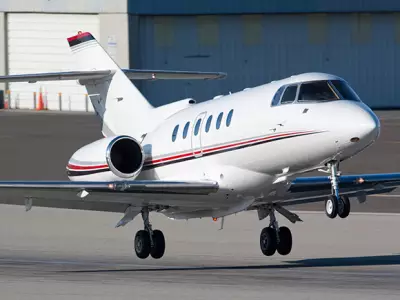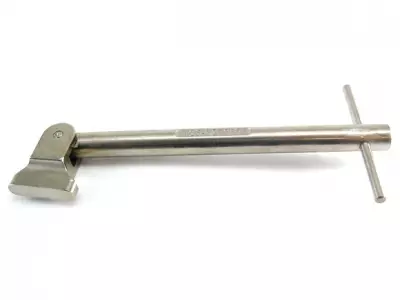Hawker 800XP
Certified in July 1995, the Hawker 800XP is a variant/replacement of the Hawker 800A/800B.
The next chapter in the incredibly successful story of the Hawker 125 Business Jet saw 426 800XPs being built and delivered between 1995 and 2005.
The Hawker 800XP offered improved payload capabilities, enhanced performance and updated systems.
Engine upgrade featured the AlliedSignal TFE-731-5BR engines. This latest design variant of the TFE731 series provided greater thrust and lower fuel consumption.
The avionics system, based on the Honeywell SPZ-8000 suite, included GPS, High Frequency communications, GPWS (Ground Proximity Warning System), TCAS II (Traffic Collision Avoidance System), and dual autopilot.
After serial number 258359, RVSM (Reduced Vertical Separation Minimums) certification was standard from the factory. For earlier serial numbers, the mandatory upgrade to RVSM was achieved via Factory Service Bulletin SB-34-3110 (Honeywell) or SB-34-3166 (Collins).
With the 800XP, the top-of-wing stall fences were replaced with ‘vortilons,’ a small, blade-like fence attached to the underside of the wind. While producing less drag than stall fences, vortilons delay a stall's onset, and ensure that the wings' roots stall before their tips. They do this by creating a vortex that extends over the top of the wing,
Vortilons also enhance the aircraft’s performance by allowing faster time to target takeoff speed, and assisting with greater control of vertical speed on approach for landing.
Like all variants of the 800 Series, the 800XP’s roomy, stand-up cabin offers a forward galley, rear lavatory, and room for two crew members and eight passengers.
Notes of Interest
In the mid ninety’s, fractional ownership in the Business Aviation world really took off, with companies like NetJets, Flight Options, and Travel Air placing huge orders for hundreds of business jets each year. There is absolutely no doubt that these fleet purchases gave a needed boost to the Business Aviation Industry. The Hawker 800XP was an ideal candidate for Fractional Jet Ownership, and close to ½ of the 800XP’s ever produced started their existence in one of those fleets. This may help explain why 426 Hawker 800XP Business Jet were produced and sold in a ten years span from 1996 to 2005, vs only 278 of the 800’s being sold in the previous twelve years (1983 to 1995). The Hawker 800XP's will always stand out as one of the most popular, reliable mid-sized business jet ever sold.
Testament to the strength of the Hawker Airframe and reliability of the airplane and its systems:
On Monday, August 28, 2006, a Hawker 800XP, operated by NetJets under its fractional ownership program, was on a routine afternoon flight from Carlsbad, CA to Reno, NV when it was struck by a glider at 16,000 feet. Miraculously, the Glider Pilot was able to deploy a parachute and made it back to earth safely. The wing of the glider struck the nose cone of the Hawker and came all the way through to the cockpit, with the Captain’s instrument panel being destroyed. Parts of the Glider also struck the right wing and engine, knocking the engine out of service. The Captain, an ATP rated female pilot with tons of experience in the Hawker 800XP, had to hold part of the instrument panel up with her foot while the crew donned Oxygen masks and attempted to get the situation under control. They declared an emergency and requested vectors to Reno, twenty miles North of their position. When they saw Carson City Airport out to the right side of the aircraft, they elected to land there instead. On emergency approach to Carson City, with wind blowing into the cockpit, an engine out, and a huge chunk of the wing missing, the crew discovered that the landing gear was damaged and would not deploy. The crew did one fly-by of the tower, then came around and landed the Hawker Jet without further incident. There were no injuries to the passengers, and one passenger was quoted as saying that the landing was actually quite smooth. The airplane skidded to a smooth stop, and everyone on board survived to tell the story. It was determined that the cause of the accident was that the Glider Pilot had turned off his Transponder to save battery life. Had the Transponder been on, the TCAS II Collision Avoidance System in the Hawker would have most likely detected the Glider in time to avoid the collision.

| Manufacturer | Hawker Beechcraft Corp. |
|---|---|
| Years Built | 1995 to 2005 |
| Serial Number Range | 258266 to 258722 |
| Units manufactured | 426 |
| Units In Operation as of 01/01/2022 | 392 |
| Length | 51.1 ft; Height: 17.6 ft; Wing Span 51.4 ft |
| Capacity | 2 Crew; 8 Passengers |
| Ramp Weight with full fuel | 28,120 lbs |
| Max Take-off Weight | 28,000 lbs |
| Average Cruise Speed | 430 knots |
| Ceiling | 41,000 ft |
| Climb Rate | 3,415 feet per minute |
| Range | 2,470 NM with seats full |
| Engines | Two Honeywell TFE 731-5BR-2C’s (latest Honeywell modification as of 01/01/2021) |
| TBO | 5,000 hours |
| Thrust | 4,750 lbs |




